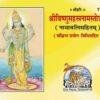India is a land of diverse cultures and religions, and festivals are integral to its rich heritage. Mesha Sankranti is one such festival celebrated enthusiastically in various parts of the country. Mesha Sankranti, or Sankranthi or Vishu, is a Hindu festival that marks the beginning of the solar year and the onset of spring. It is observed on the day of the Spring Equinox, which usually falls on the 14th or 15th of April. This year it is on Friday, April 14, 2023. Mesha Sankranti is a time of joy and renewal, as it signals the arrival of spring and the start of the new agricultural season.
Mesha Sankranti is primarily celebrated in the states of Andhra Pradesh, Telangana, Karnataka, and Maharashtra, and each region has its unique way of celebrating the festival. The festival is a reminder of the importance of gratitude and giving, as people donate to the needy and give thanks for their blessings. The day of Mesha Sankranti is considered auspicious, and people perform puja (worship) to seek blessings from the gods. Mesha Sankranti is a time of new beginnings, and people start new ventures, relationships, and tasks on this day, believing that it will bring them success and prosperity.
In this article, we will discuss the significance of Mesha Sankranti, the rituals and traditions associated with the festival, and how it is celebrated in different parts of India. We will also discuss the puja vidhi for Mesha Sankranti (worship procedure) and the Mahurat (auspicious time). The article aims to provide readers with a comprehensive understanding of the festival and its significance in the Indian cultural landscape.
Puja Vidhi of Mesha Sankranti

The puja vidhi (worship procedure) for Mesha Sankranti involves several steps, which are as follows:
Cleanliness
Cleanliness is an essential aspect of the puja vidhi (worship procedure) for Mesha Sankranti. People clean their houses and surroundings to welcome the festival with a clean and pure mind and body. The idea behind cleanliness is to create a positive and conducive atmosphere for the puja and to make the environment more pleasant for the guests.
Before starting the puja, people take a bath and wear new clothes. This is done to purify the body and mind and to create the festival with a fresh and positive attitude. After a bath, people sprinkle water in their houses to purify the space and remove negative energies.
Cleaning the house is also an essential aspect of the puja vidhi. People sweep the floors, dust the furniture, and decorate their homes with flowers and rangolis (colourful patterns made with powdered colours). The idea is to create a clean and welcoming atmosphere for the guests and to make the environment more conducive to worship.
Cleanliness is also essential when preparing prasad (holy offering made to the gods). People wash the ingredients thoroughly before using them to make the prasad. This is done to ensure that the prasadam is pure and impure-free.
Preparation of Prasad
Preparing prasadam is an essential aspect of the puja vidhi (worship procedure) for Mesha Sankranti. Prasadam is a holy offering made to the gods, and it is believed that offering Prasad brings blessings and good fortune.
People prepare unique dishes, such as chakra pongal, payasam, and sesame seed balls, as Prasad. These dishes are made using traditional recipes and are believed to be liked by the gods. The preparation of prasad is done with great care and devotion and is considered a sacred act.
The ingredients used in Prasad are carefully selected and are believed to have spiritual significance. For example, sesame seeds are considered auspicious and are used to prepare Prasad. Jaggery, a type of unrefined sugar, is also used in prasad, as it is believed to have purifying properties.
Before starting the preparation of Prasad, people clean the kitchen and the utensils. This ensures that the prasad is prepared in a clean and pure environment. The ingredients are then washed and cleaned before use.
During the preparation of prasad, people recite mantras and invoke the blessings of the gods. The prasad is then offered to the gods, along with flowers and other items.
After the puja, the prasad is distributed among the guests. It is believed that eating prasad brings blessings and good fortune.
Offering Puja
Offering puja (worship) is an essential aspect of the puja vidhi (worship procedure) for Mesha Sankranti. It is a way of showing devotion and seeking the blessings of the gods.
The puja is performed in the morning after bathing and wearing new clothes. The puja room is cleaned and decorated with flowers and other items. The deities are then placed in the puja room, and the puja begins.
The puja starts with the lighting of a lamp, which is believed to symbolize the presence of the gods. Incense sticks are also lit, and the fragrance is believed to purify the environment and create a conducive atmosphere for the puja.
During the puja, mantras are recited, and offerings are made to the deities. The offerings include fruits, flowers, and prasad (holy offerings made to the gods). The puja is performed with great devotion and reverence, and it is believed that offering puja brings blessings and good fortune.
After the puja is over, the prasad is distributed among the guests, and it is believed that eating prasad brings blessings and good fortune.
In some households, a special puja is performed for the sun god, as Mesha Sankranti is the day when the Sun enters the zodiac sign, Aries. The puja is performed with offerings of water, rice, and flowers, and it is believed that offering puja to the sun god brings health, wealth, and prosperity.
Donation
Donation or charity is an integral part of the Mesha Sankranti celebrations. It is a way of giving back to society and helping those in need.
Donation is considered noble and believed to bring blessings and good fortune. It is believed that donating can eliminate negative karma and improve their chances of attaining moksha (liberation).
On Mesha Sankranti, people donate clothes, food, and money to the poor and needy. They also offer donations to temples and other charitable organizations. Contributions are made with the belief that they will bring happiness and prosperity to the donor and the recipient.
In some regions, people also perform annadanam for Sankranti (donation of food). It is a sacred act, and it is believed that by offering food to the needy, one can attain the blessings of the gods. People set up temporary kitchens and cook food for people in need. The food is served on banana leaves, and people sit on the ground to eat the food.
Donation is also seen as a way of honouring the sun god, believed to be the source of all life on Earth. By offering donations, people express gratitude to the sun god and seek his blessings.
The Maha Punya Kala for Mesha Sankranti

The Mahurat for Mesha Sankranti, falls on Friday, April 14, 2023. The Punya Kala, or the auspicious period for performing rituals and pujas on this day, is from 09:27 AM to 05:56 PM, lasting 8 hours and 28 minutes. This period is considered highly auspicious and is believed to be beneficial for performing religious activities or starting new ventures.
The Maha Punya Kala for Mesha Sankranti, or the most auspicious time for performing puja, falls between 11:35 AM to 03:49 PM, lasting 4 hours and 14 minutes. Any ritual or puja performed during this time is believed to bring maximum benefits.
The Mesha Sankranti moment, which marks the entry of the Sun into the Aries zodiac sign, falls at 01:42 PM. Performing religious activities during this time is highly beneficial and brings good luck and prosperity.
It is important to note that these timings may vary based on the location and the regional customs and traditions.



















Add comment